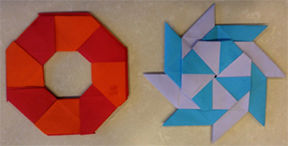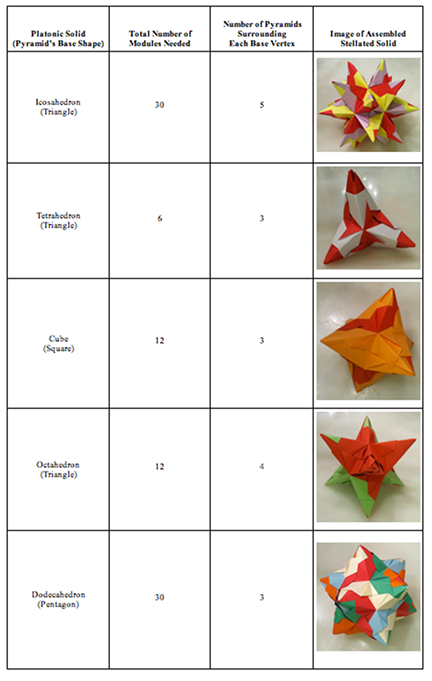I run an after-school math
club for fourth and fifth graders to share ideas and puzzles with a strong mathematics
content without necessarily appearing so. It is not a competition-oriented
group. Instead, I offer differentiated challenges, encouraging exploration and,
I hope, some joy and inspiration.
Looking
for another activity for the club, I found the
NCTM Illuminations
Pinwheel activity. Here’s an easy-to-follow
YouTube™ video
for
those who might benefit from a video demonstration. I liked the visual-spatial,
geometric, and fine-motor skills that the activity would require for these
younger students. Following are two examples that my fifth-grade daughter made
during the club activity. The pinwheel is an eight-piece modular assembly. Modular
origami creates shapes using multiple pieces of similarly folded paper that are
then assembled.

To
expand on that enthusiasm, I looked for other modular origami activities that the
students could approach. One of our language teachers suggested that we try a three-dimensional
origami star. (See the stellated icosahedron in the table below.) It was a
complicated, 30-module construction, but the students were highly motivated. Several
videos described this shape; we used https://www.youtube.com/watch?v=R1XTt73diyY&feature=fvwrel.
Watching students persevere through the folds and assembly was deeply inspiring
and motivating to me.
One of
the more fascinating parts of this activity happened during module assembly. To
put the star together, we used three pieces of paper folded into one another to
create each equilateral triangular pyramidal “spike” (see video).
-
We noticed that at each vertex of the triangular
bases, the lateral edges of five pyramids met. One of these 12 vertices can be
seen at the top of the image in row 1 of the table. Counting the outward
pyramids in the completed figure, we found 20. That’s the number of underlying
triangular bases.
-
The shape used 30 pieces of paper with each
folded in half forming parts of two different pyramids, making 30 base edges.
- From
Euler’s formula, I recognized the formal underlying structure. The overall
star was really a stellated icosahedron—an icosahedron with a pyramid on
each face. And if we could stellate an icosahedron, why not the other
Platonic solids, too?
Using
the same folded modules needed to construct our first three-dimensional star
(shown in the YouTube video), we went beyond our pictures and instructions to
create shapes that mathematics told us were there but that none of us had ever
seen before. The following table shows our other creations—making one for each
Platonic solid. (The stellated dodecahedron was the most difficult, with
“loose” pyramids that required tape inside during assembly to hold together.)

It was amazing
to see all these three-dimensional objects assembled from the same module. The
key is in the orientation. Enjoy!
(You
can also see the Platonic duals in the paper needed for each star—a task that was
beyond my math club students.)

CHRIS HARROW, [email protected], a National Board
Certified Teacher, is the mathematics chair at the Hawken School in Cleveland,
Ohio. He blogs and presents nationally on the educational uses of technology
and on Computer Algebra Systems (CAS) in precollegiate mathematics. He is also
the recipient of a Presidential Award for Excellence in Mathematics and Science
Teaching.